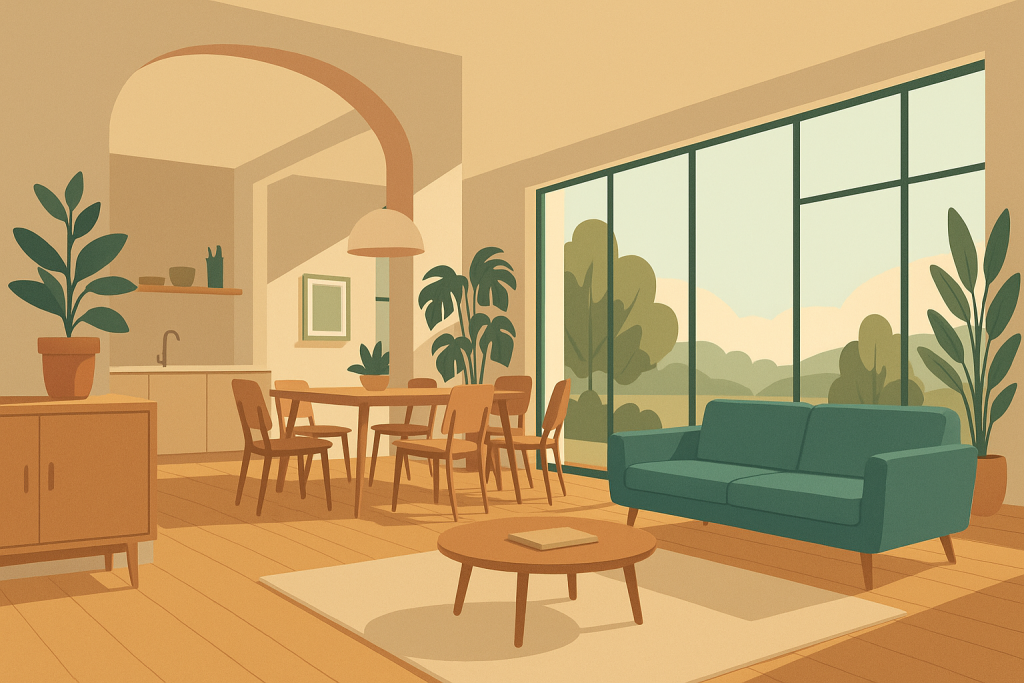Every aspect of our living environments influences our mood, focus, and mental energy. The key focus of this article—home layouts mental clarity—explores the emerging architectural and interior trends that help declutter the mind and improve cognitive well-being.
Unlock the link between home layouts mental clarity and daily serenity. This post uncovers the latest trends—from open spaces to nature-inspired rooms—that support focus, reduce stress, and help you thrive mentally.

1. Open Floor Plans and Cognitive Flow
A major trend in modern housing, open floor plans eliminate walls between living, kitchen, and dining areas. This layout supports how our brains crave spaciousness and ease:
- Reduces visual clutter: Fewer walls mean fewer visual boundaries, minimizing distractions.
- Heightened natural light: Expansive spaces allow sunlight to flow freely—crucial for serotonin production and circadian regulation .
- Improved social cohesion: Families naturally gravitate towards common areas, supporting shared focus and relaxation.
Evidence is mixed—some users feel overwhelmed without private zones—so balance by creating distinct quiet corners.
2. Biophilic Design: Green Homes, Clear Minds
Bringing nature inside isn’t just trendy—it’s scientifically proven to boost mental clarity:
- Harvard researchers noted green-certified buildings improved cognitive function by up to 26% compared to standard designs.
- Direct natural elements (plants, wood, water features) reduce cortisol levels and foster calm realsimple.com.
- For neurodivergent individuals, biophilic touches can ease sensory overload and support focus.
Simple actionable tips:
- Add potted plants or a green wall.
- Use natural materials (wood floors, stone surfaces).
- Maximize daylight with skylights or large windows.
These create environments that help minds breathe and think clearly.
3. Room Geometry and Emotional Response
The shape of our rooms affects more than space—it influences mood too:
- Studies using VR setups show curved rooms promote positive emotions, whereas harsh rectangular shapes can heighten negativity.
- Interior psychologists suggest gentle curves be introduced via furniture, wall niches, or archways to ease cognitive strain.
By softening architecture, we support calm, less cluttered thinking.
4. Decluttering & Spatial Flow
In the world of design, less is often more—especially for mental clarity:
- Cluttered spaces are linked to higher cortisol levels, impaired concentration, and stress .
- Adopting spatial flow strategies—like the KonMari method—helps turn physical order into mental focus.
Fast decluttering checklist for clarity:
- Eliminate items that don’t serve purpose or joy.
- Use built-in or hidden storage to maintain clean surfaces.
- Keep traffic paths clear to preserve visual and psychological flow.
5. Light, View & Circadian Harmony
How we use light dramatically affects mental clarity:
- Exposure to natural light and outdoor views aids sleep, reduces anxiety, and enhances memory.
- Position your workspace near windows or reflect daylight using mirrors.
A home designed around light nurtures both clarity and well-being.
6. Mixed-Use Spaces with Quiet Refuges
While open plans offer brightness and connection, our evolving needs demand variation:
- Biophilic designers also emphasize prospect and refuge—the balance of open sightlines with sheltered nooks.
- Include alcoves, small reading zones, or cozy benches that provide quiet escape without isolation.
This diversity in layout supports both mental stimulation and restful retreats.
7. The Role of Minimalist, Smart Design
Technology-enhanced homes can simplify life—but also clutter:
- To preserve mental clarity, embrace smart systems that are concealed: hidden cables, built‑in storage, voice‑activated lighting.
- Minimalist design—neutral palettes, sleek lines, multipurpose furnishings—prevents overstimulation.
This approach helps home layouts mental clarity by keeping spaces uncluttered and functional.
8. Emerging Trend: Biophilic Pods & Work Corners
As remote work continues, innovative layouts are growing:
- Designers now build micro-nooks—mini green offices within living rooms or bedrooms—to separate work from home life.
- These pods include plant walls, curved partitions, natural light, achieving both privacy and mental restoration.
This trend reinforces the value of both openness and intentional retreat.
9. Practical Guide: Transform Your Space for Clarity
Here’s a step‑by‑step walkthrough aligned with home layouts mental clarity:
- Plan your layout:
- Map out open, biophilic, and retreat zones.
- Decide on natural lighting and furniture flow.
- Add nature mindfully:
- Introduce 1–2 large indoor plants; transition to greenery walls.
- Choose natural materials and textures.
- Declutter ruthlessly:
- Remove nonessential items.
- Use hidden or multifunctional storage.
- Soften room geometry:
- Add curved furniture or arches.
- Avoid stark right angles in focal zones.
- Enhance lighting:
- Use sheer curtains; mirror placements; desk near windows.
- Integrate smart dimmers for evening calm.
- Create refuges:
- Set up cozy alcoves with cushions and soft light for downtime or reading.
- Refine with tech:
- Hide cables; employ built-in units; rely on wireless devices.
- Voice control lighting/music for convenience.
10. Why It Works: The Science Behind the Design
- Cognitive Load Theory: Less visual distraction means less mental strain, improving focus.
- Attention Restoration Theory: Natural environments replenish cognitive resources.
- Biophilia Hypothesis: Humans have an innate attraction to nature, promoting calmness in green spaces.
These theories provide a solid foundation for why home layouts mental clarity trends resonate.
Conclusion
Home layouts mental clarity is not just a buzzword—it’s backed by research and real-life user benefit. Emerging design trends like open-concept flow, biophilic elements, decluttered spaces, and mixed geometry support mental clarity and emotional health. By thoughtfully rearranging our homes, we can craft environments that bolster our focus, resilience, and calm—no dramatic overhaul required.
References
- Arc-shaped rooms and mood: NCBI study on room geometry and affective states. PMC10965811.
- Biophilic design benefits: Integris Health report (2024).
- Psychological well-being in residential design (ScienceDirect, 2024).
- Effects of clutter on cortisol, focus, mental clarity (Mental Health America).
- Biophilia hypothesis – Wilson EO, 1984; benefits of nature exposure.
- Natural light and serotonin: Dongardner/Marymount blogs; NCBI data.
- Harvard study on green buildings and cognition.
- Neurodiverse benefits of biophilic environments – WEF 2024.






